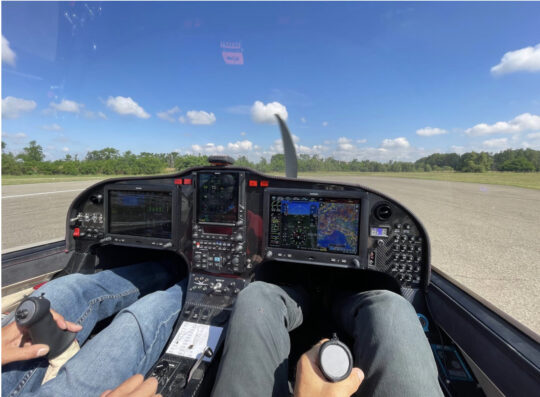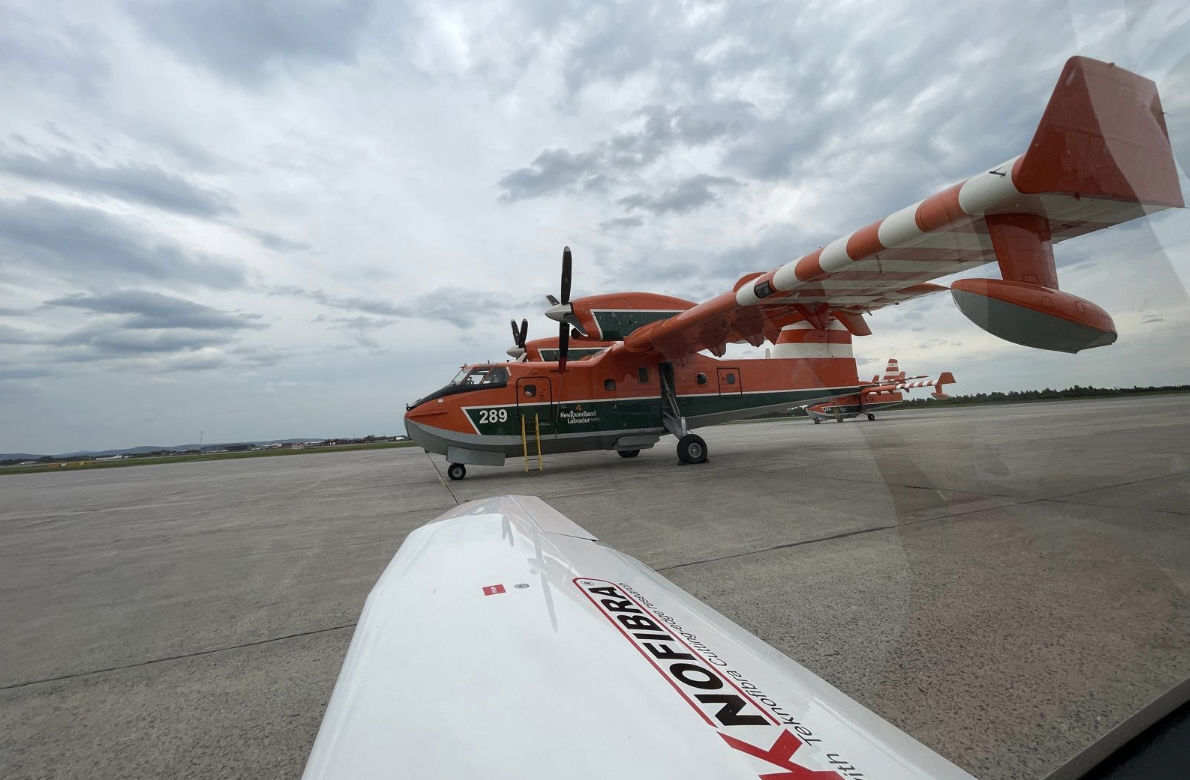We recently reported that the newest version of the sleek, retractable-gear Risen had made a successful transatlantic crossing. From what we could piece together from outside accounts and posts on social media, it went well. But here’s a more first-person look at the crossing, from the perspective of the right seat.
Andrea Venturini accompanied designer Alberto Porto on the epic journey across the pond. Here’s his account.

Ready to depart Voghera in Italy.
It all started last December, with a phone call I received from Alberto Porto. At the time, I was in Australia doing a report at the Gliding World Championship for theItalianTeam. Onthephone Alberto, designer and builder of the fastest ultralight in the world (430 kph/232 knots), with the simplicity that always distinguishes him, says: ”Andrea, keep yourself free for next June, I’ll detail everything when you return to Italy.”
You can imagine my curiosity in the meantime. A few weeks later, the mystery was revealed: the Risen Superveloce with the brand new Rotax 916 iS must be brought to Oshkosh, to AirVenture, the largest and the most important aviation fair ‘of the Universe.’ I knew well what Oshkosh meant. A strange word in Italian; it’s the headquarters of the EAA, basically an immense display of aircrafts with thousands of people camped under their wings for about a week. The show comprises hundreds of aeronautical displays that take place from 6am until deep into the night. I still remember the flames from a show with a squadron of A10s that made a low-pass. The napalm explosions made my face hot from hundreds of meters away, a huge fireball raised in the night sky. As I have always said, every pilot, at least once in his life, must visit Oshkosh.

The planned routing.
So, if I understand correctly, Alberto wants me to accompany him on the Risen to Wisconsin. Mmm, but which way do we actually go? I know well that the year before he delivered a Risen Superveloce to the States but he then passed through the “classic” North Atlantic route Scotland, Iceland, Greenland, Canada.
This time, however, the plans are way more ambitious: The idea is to fly the new Risen Superveloce, with a Rotax 916i without stopping to refuel, leaving from Stornoway, Scotland. Basically doing something that only the Risen Superfast can do—fly at speed beyond 300 km/h, with 20 knots of headwind consuming only an average of 18 liters (4.5 gallons) per hour.

Andrea, foreground, dons the survival suit before crossing the Atlantic.
First comments I heard were: “It is not possible.” Instead I thought: Well, let’s see if it’s really impossible. The plane is here, the two “crazy” pilots are here, for me the mission it’s already done….
We still have to do the math properly and analyze the flight data in detail, but the approximate summary is this: we left from Voghera [near Genoa, Italy] with only one straight route, landed at the Outer Hebridean islands, Scotland, to the only refuel before the second important leg.
The ocean route, directly from the Hebrides to Canada, was approximately 3300 km flown in 11 hours. As I said before, at the moment we are still gathering the data, but the average speed estimated in the various sectors for each leg, was between 165 knots (305 kph) and 200 knots (370 kph), covering a total of 4050 nautical miles (7500 km), all of this using just over 100 gallons!

The first sign of civilization after 10 hours over nothing but water.
The ocean crossing, against the wind toward the west, with an aircraft that is truly an ultralight and without stops either in Greenland or Iceland for refueling—it’s now a reality. An incredible flight has just been completed with a recreational aircraft, all this thanks to extremely efficient parameters of the plane. The secret of the Risen relies precisely on this: efficient and clean aerodynamics, like no other aircraft, which allow you to make the best use of the engine. All of this is available to pilots whether you want to break a speed record or just cruise along at 2.1 gallon an hour at speed.
The two-seat all-composite Risen has proven itself a speedster with the normally aspirated 912 and even more so with the turbocharged 915 previously fitted. With the new, more powerful Rotax 916 iS available, this is the first of the Risen to use it. This airplane will be on display at AirVenture next month.

An escort into Canada.

From the customs office in Appleton… success!



Crossing the big pond (Atlantic ocean) by plane and sailing boat is on my bucket list.
I like to read that the technology is now available; I would like to be a passenger on those flights.
I am a glider and pilot on week end.
Daniel a Perrault p.eng
Graduated in aerospace engineering
But work as energy entrepreneur
When talking about this aircraft, you have to consider the Shark Aero which has a Rotax 912. It will reach 300KmPH and consume 4-6 Gal. per hour. It has a range of 2000 Km. The Shark is the plane brother and sister Mack Rutherford and Zara Rutherford each flew around the world as teenagers. And, it is only $150,000.
* 7,500 kilometers = 4,660 miles
* 4,660 miles / 100 gal. = 46.6 miles miles per gallon.
* Better yet, there was a 20 knot headwind…..(assume an average of 10 knots)
* Average speed between 165 and 200 knots….(assume 180 knots as the average speed)
* 7,500 kilometers = 4,050 nautical miles.
* 4,050 nautical miles / 180 knots = 22 1/2 hours of flight time
* 10 knots = 11 miles per hour
* 22 1/2 hours x 11 mph = 247 miles
* 4,660 miles + 247 “miles” = 4,907 miles
* 4,907 miles /100 gal. = 49.1 miles per gallon
I did this hurriedly, so someone check my math.
In the original Risen, the wings could be made to accommodate 52 gallons. 26 gallons in each tank. On the first cross Atlantic flight with the Rotax 912 ULS engine Alberto flew solo at around 118 mph. With this engine burning more fuel, as it is a turbocharged engine, with the speed quoted had to have not only the 52 gallons, if that is even possible with the shorter wing, plus an extra fuel bladder in the back seat.
Flying at the higher speed requires more fuel. Not possible with the speed they flew.
One of the things that is unknown is that this engine is 160 hp. If they flew at even just over 60% power, they still had 100 hp, which is what the original Risen used, to fly with. With a shorter wing you have more speed and less drag.
Yet making the trip in just over 11 hours is quite amazing.
They did not have extra fuel bladders. They have bigger tanks on this model.
I have been on the constant search for a fast and efficient cross country cruiser. This might be just the ticket! Unfortunately, most the others that I have already looked at are out of the common mans budget. The few that I have already researched are well over $200K, no pricing listed on Risen’s site.
The normal Risen with the Rotax 912iS engine is with currency exchange over $300,000. My guess is this plane with a Garmin G3X suite would be around $375,000.
You might ask why so high? It comes down to quality and low numbers being produced. Hence labor cost is higher.
Mooney 252 has 4 seats and used price $250K loaded for IFR. certified to FL 280.
There are added expenses not mentioned on all new builds. It comes into play because of the FAA 51% rule. That means you would be spending over a month in Italy building the plane. Most likely in two separate trips.
With a really nice 48 inch wide cabin plus literally every feature beating all other microlights or LSA’s today, in reality the price tag might be well over $100,000 more.
On occasion a used older plane, not the SV, comes available. Then you have the $300,000 plus price tag but fully built.
This plane really is the best of the best. The only thing I don’t like is that the wings come off for easy moving and storage. That was the only fatality to date. And it was a SV. The owner didn’t do due diligence in tightening one wing.
When mosaic is finalized into a law next year, these will not require experimental tag or 51% rule
I would agree.
I was calculating the price on what the original Risen went for. Assuming we are past MOSIAC, the original Risen is more likely $350,000. The SV would likely put it over $400,000. Not a cheap plane but in my opinion, the best there is in nearly way.
Maurice,
I was thinking about what you said on the 51% build rule for experimental class and as far as I have seen so far, it still applies unless it has a different classification.
If it can get an STC or an LSA certified rating then yes but as far as I have seen the self build and build centers will still be used on experimental aircraft. And so far microlight aircraft are experimental.
If you do the math & divid 4050 miles by 100 gallons you get 40.5 miles to a gallon of fuel.
Or like 4 gallons of fuel would take you 162 miles with a 20 mile per hour headwind is pretty amazing.
An incredible feat for an ultralight/light sport category aircraft. Hopefully many legacy GA flyers are paying attention to the upcoming revolution under the new MOSAIC rules.
I doubt it. They are still in denial and many actually hope MOSAIC “never” becomes law! Most GA sat on their laurels for decades in a monopoly, and soon they will be relics. I’m 7 months into a JMB VL3 916IS order, and will never look back!
I agree. The VL3 Evolution is an incredible plane. It has a tighter cabin than Risen.but very well made. The difference is actually quite small. Enjoy your plane!